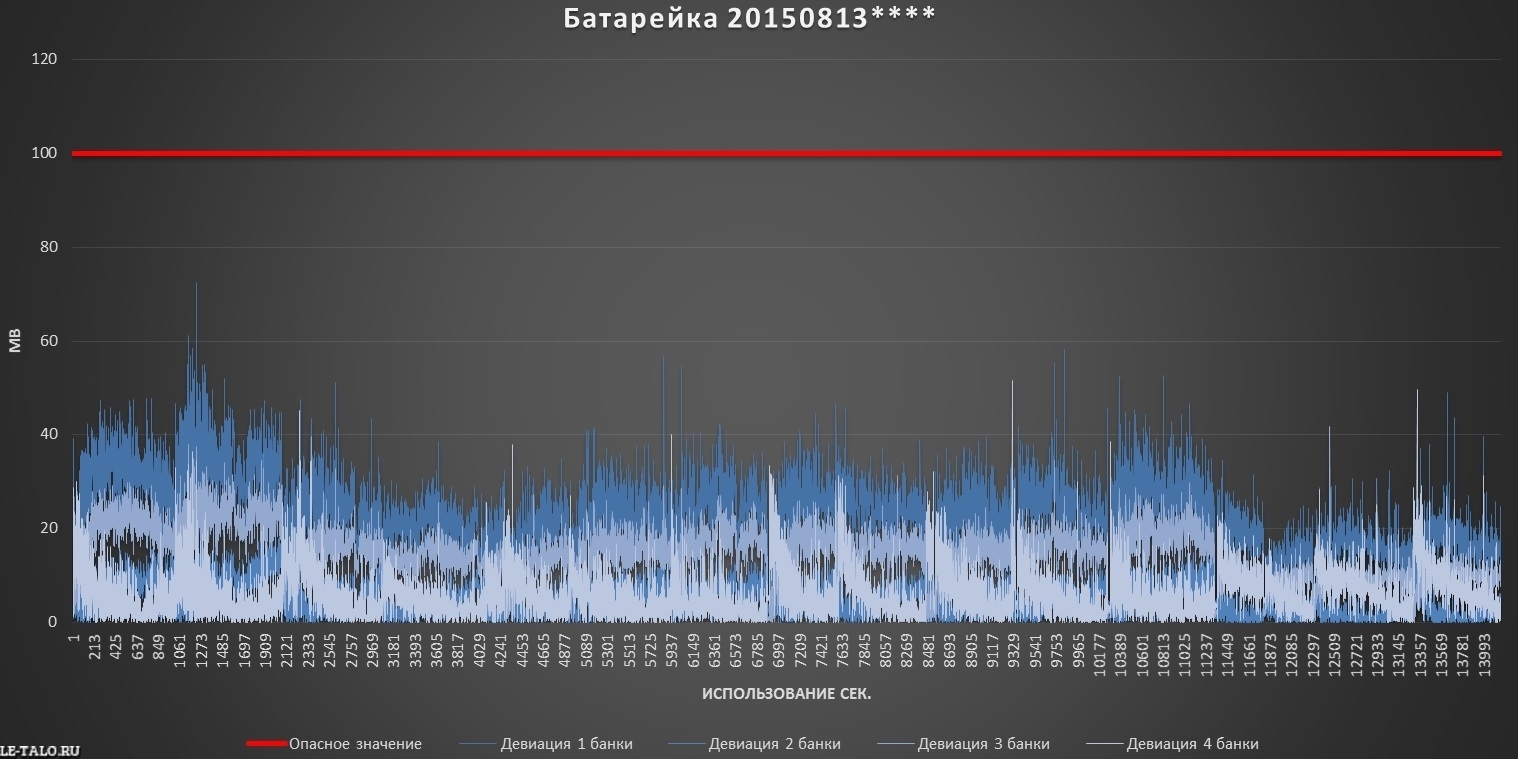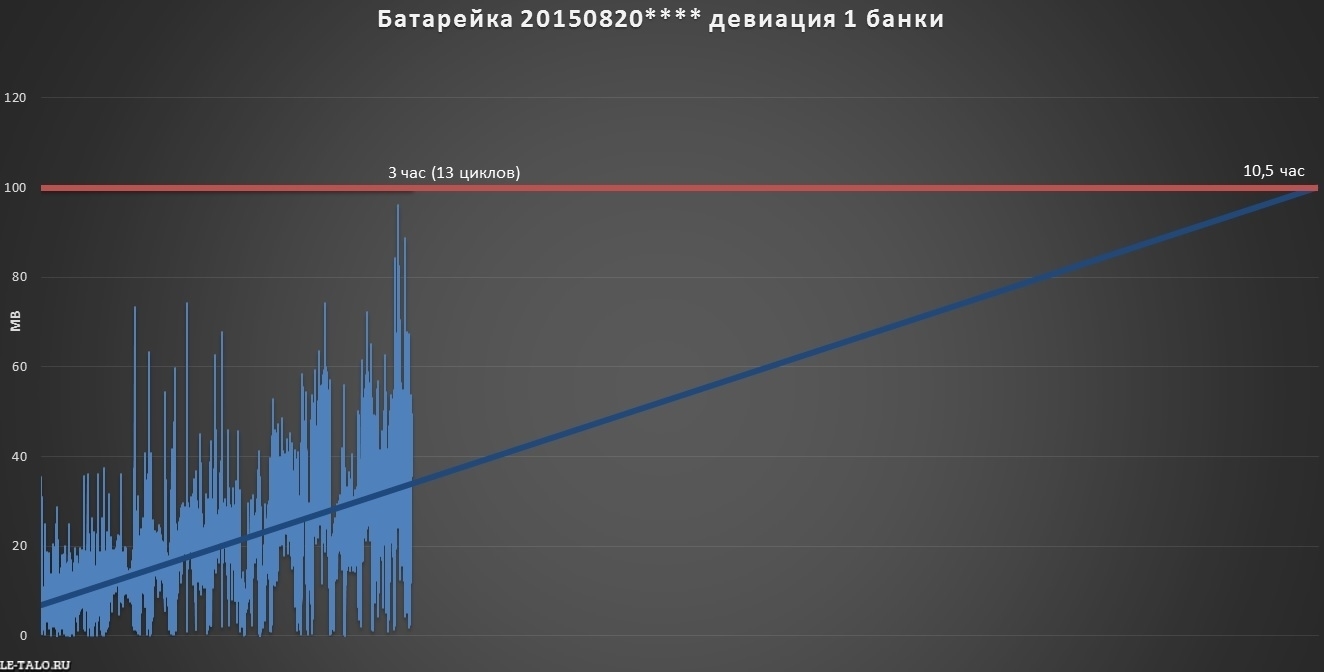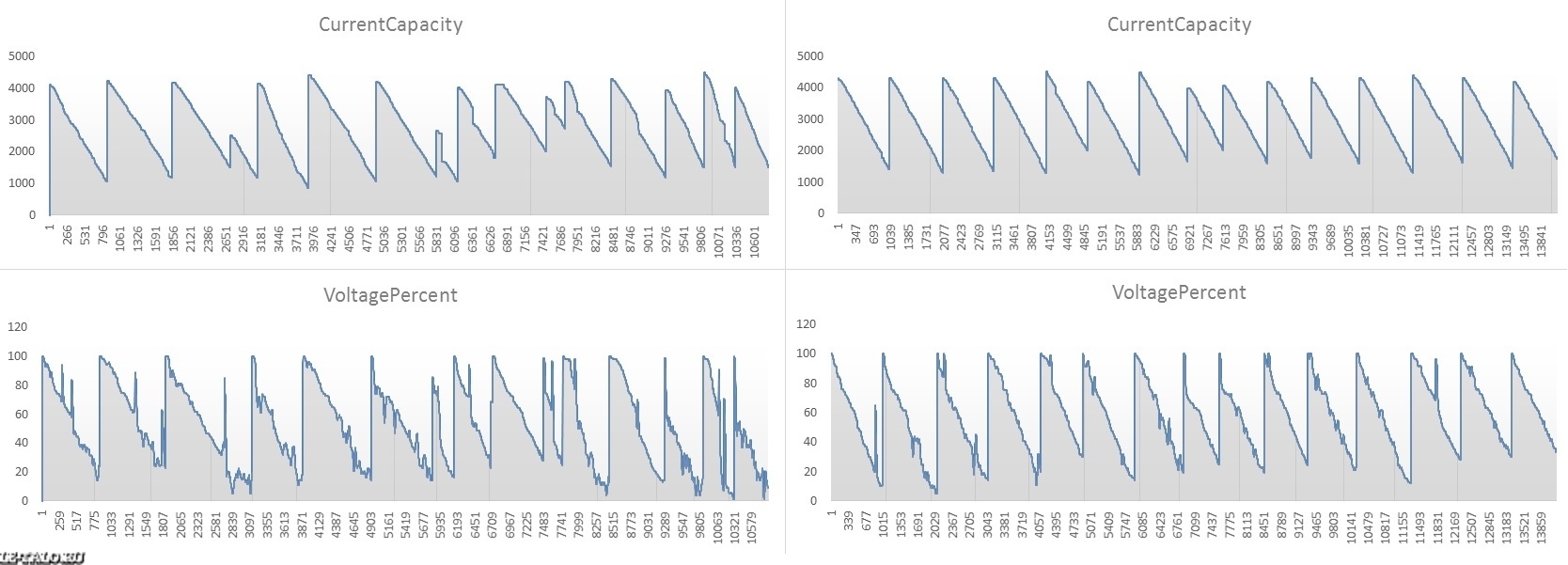Almost the whole truth about the battery DJI Phantom 3
As I promised in the previous article , this material will be devoted to a phantom battery review. About the merits of these batteries and how smart they are, they will tell me about it on the manufacturer’s website, but I’ll give you the opinion that I had formed while watching the heap of flight logs of Jedi phantoms.

')
Newer batteries can behave completely differently. The Jedi arefixing bugs, updating firmware, possibly changing production technology on the move, opening factories, and amidst such rapid development it seems difficult to track down the quality. They themselves recognize the chance to run into defective products, and in this case they make contact, offering to throw off the flight logs for which they determine the quality of the battery, after which the defective battery changes under warranty.
Here I evaluated the quality of the battery by the deviation of the cans and found two variants of the initial state of the battery. In the first variant, the small deviation slowly begins to increase with time, which, alas, cannot be avoided, or the deviation of about 30-50 mV may initially be present, but after the first run-in cycles it decreases and then behaves similarly.

The second option, when the deviation after the first cycles of use begins to grow rapidly and threatens to reach dangerous values for the first couple of dozen flights.

If we linearly approximate this graph and try to predict what will happen next, then the deviation of the first can from the graph just above can reach dangerous values in about 20-30 cycles. By dangerous values, I mean 0.1V. It should be added that for the deviation I consider the greatest deviation of any battery bank from the average-arithmetic value for all banks, and if the deviation is 100mV, then the delta between the most charged and progressed banks is obviously more than 100mV. After this threshold, the battery should be monitored very carefully, do not fly over dangerous areas, since the drawdowns of even one bank threaten to lose power, and push the letters in support of the Jedi.

The graph shows that the deviation of the first bank is always a little more than the others. This is usually a bank located closer to a plus, but not the essence. The fact is that the battery does not gradually die completely, but from one of the cans. But it is possible to replace a dying bank, but although there are detailed instructions on the replacement video on the network, only the very best are ready to do this.

The charts are almost new batteries, past 10-15 cycles. On the left is the battery, whose deviation is increasing rapidly, and on the right, the battery is in perfect condition. You may notice that the deviation of the battery cans more often begins to increase in those who are aggressively piloting. I estimated the piloting style according to the voltage graphs, which show drawdowns at the moment when the pilot abruptly changes the direction of movement, quickly takes off and generally performs actions leading to a large current consumption and load on the battery. I would not unequivocally argue that aggressive driving style spoils the battery, and would leave this question for open discussion, but I found it interesting to talk about the correlation of these factors. Although lithium-polymer batteries are designed for high currents, they are still used in extreme conditions for them and increased loads do not affect them in the best way.
You also need to consider that it is desirable to “break in” batteries a little before pushing the stick all the way. Battery manufacturers do not have this requirement, but rather a recommendation from personal experience.

Finally give examples of temperature graphs. Here is the same bad left and good right batteries. Visible stability is the use of good and the fact that a potentially bad battery was used in a much wider range of temperatures. This could happen both because of aggressive piloting, which led to a large load on the battery and thereby warming it up, and because of the banal warm weather, so you should not rely on them, but you can take it into account. I haven’t yet met extreme temperatures on the graphs, since I only analyzed winter logs. The lower limit is limited to brains that do not give a start until the battery heats up to at least 15 degrees, and I always considered the upper limit to be 60 degrees. If someone has logs in which the battery overheated, it would be very interesting to see how this affects its condition.
You can view your DJI logs and analyze the battery status on this site .

')
The quality of the battery depends on the lot.
Newer batteries can behave completely differently. The Jedi are
Here I evaluated the quality of the battery by the deviation of the cans and found two variants of the initial state of the battery. In the first variant, the small deviation slowly begins to increase with time, which, alas, cannot be avoided, or the deviation of about 30-50 mV may initially be present, but after the first run-in cycles it decreases and then behaves similarly.

The second option, when the deviation after the first cycles of use begins to grow rapidly and threatens to reach dangerous values for the first couple of dozen flights.

If we linearly approximate this graph and try to predict what will happen next, then the deviation of the first can from the graph just above can reach dangerous values in about 20-30 cycles. By dangerous values, I mean 0.1V. It should be added that for the deviation I consider the greatest deviation of any battery bank from the average-arithmetic value for all banks, and if the deviation is 100mV, then the delta between the most charged and progressed banks is obviously more than 100mV. After this threshold, the battery should be monitored very carefully, do not fly over dangerous areas, since the drawdowns of even one bank threaten to lose power, and push the letters in support of the Jedi.

The first bank dies faster
The graph shows that the deviation of the first bank is always a little more than the others. This is usually a bank located closer to a plus, but not the essence. The fact is that the battery does not gradually die completely, but from one of the cans. But it is possible to replace a dying bank, but although there are detailed instructions on the replacement video on the network, only the very best are ready to do this.
Service life depends on driving style.

The charts are almost new batteries, past 10-15 cycles. On the left is the battery, whose deviation is increasing rapidly, and on the right, the battery is in perfect condition. You may notice that the deviation of the battery cans more often begins to increase in those who are aggressively piloting. I estimated the piloting style according to the voltage graphs, which show drawdowns at the moment when the pilot abruptly changes the direction of movement, quickly takes off and generally performs actions leading to a large current consumption and load on the battery. I would not unequivocally argue that aggressive driving style spoils the battery, and would leave this question for open discussion, but I found it interesting to talk about the correlation of these factors. Although lithium-polymer batteries are designed for high currents, they are still used in extreme conditions for them and increased loads do not affect them in the best way.
You also need to consider that it is desirable to “break in” batteries a little before pushing the stick all the way. Battery manufacturers do not have this requirement, but rather a recommendation from personal experience.

Finally give examples of temperature graphs. Here is the same bad left and good right batteries. Visible stability is the use of good and the fact that a potentially bad battery was used in a much wider range of temperatures. This could happen both because of aggressive piloting, which led to a large load on the battery and thereby warming it up, and because of the banal warm weather, so you should not rely on them, but you can take it into account. I haven’t yet met extreme temperatures on the graphs, since I only analyzed winter logs. The lower limit is limited to brains that do not give a start until the battery heats up to at least 15 degrees, and I always considered the upper limit to be 60 degrees. If someone has logs in which the battery overheated, it would be very interesting to see how this affects its condition.
You can view your DJI logs and analyze the battery status on this site .
Source: https://habr.com/ru/post/392431/
All Articles